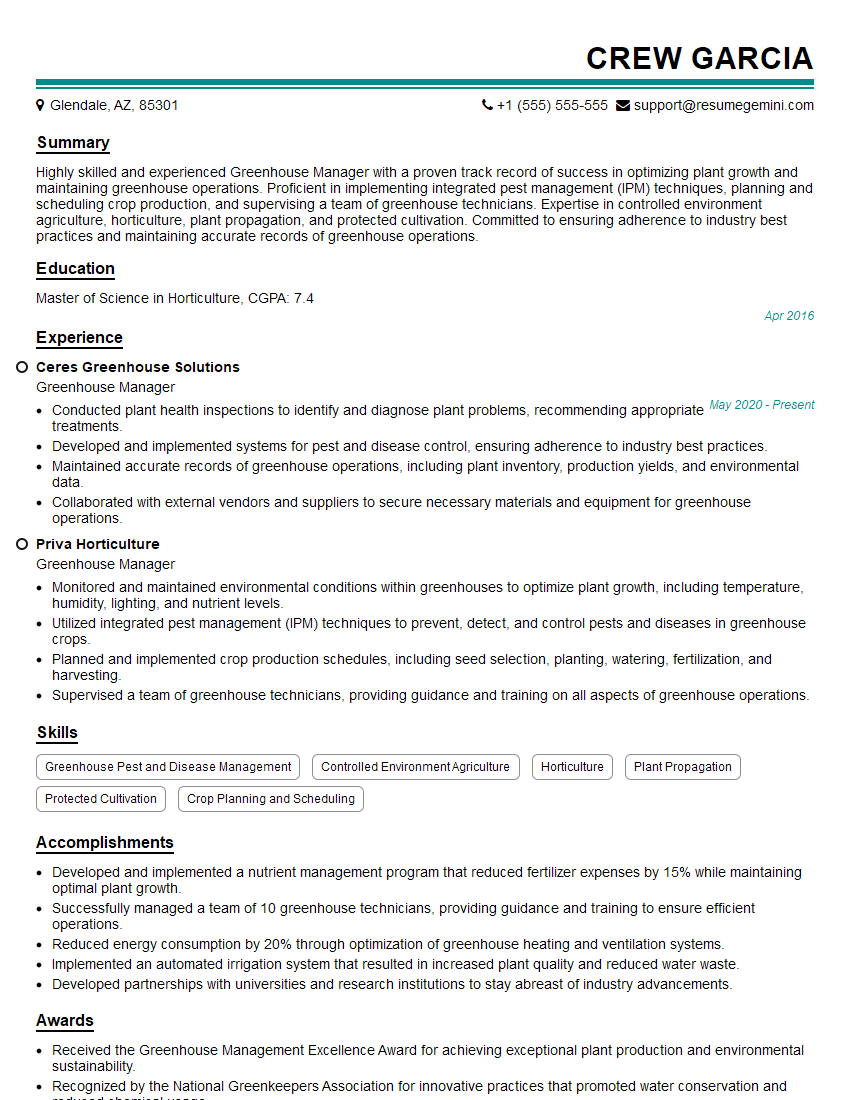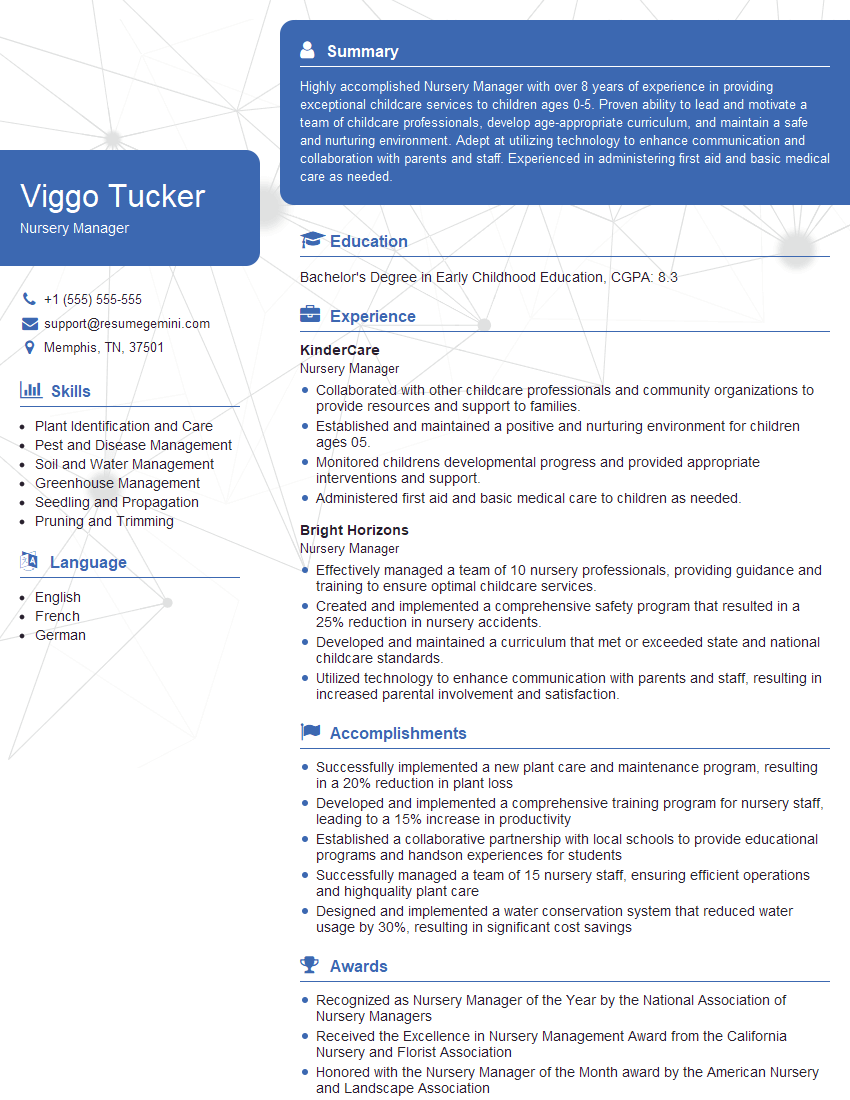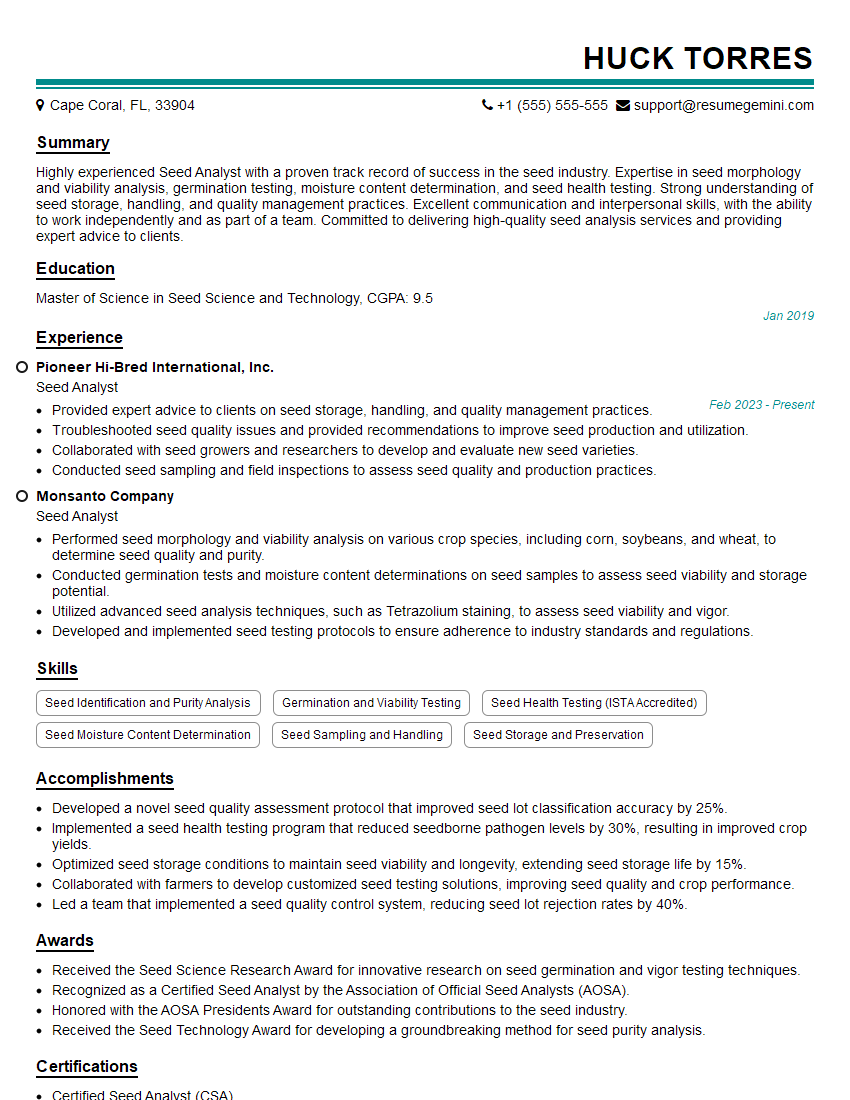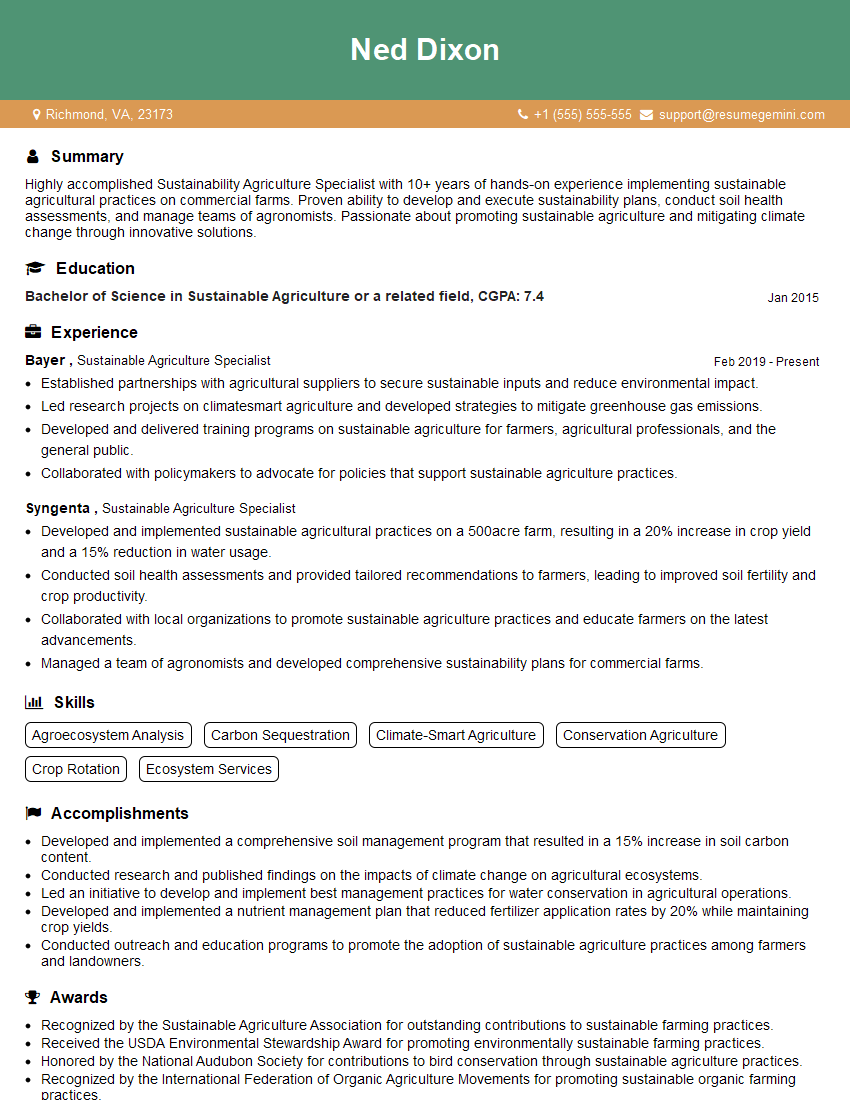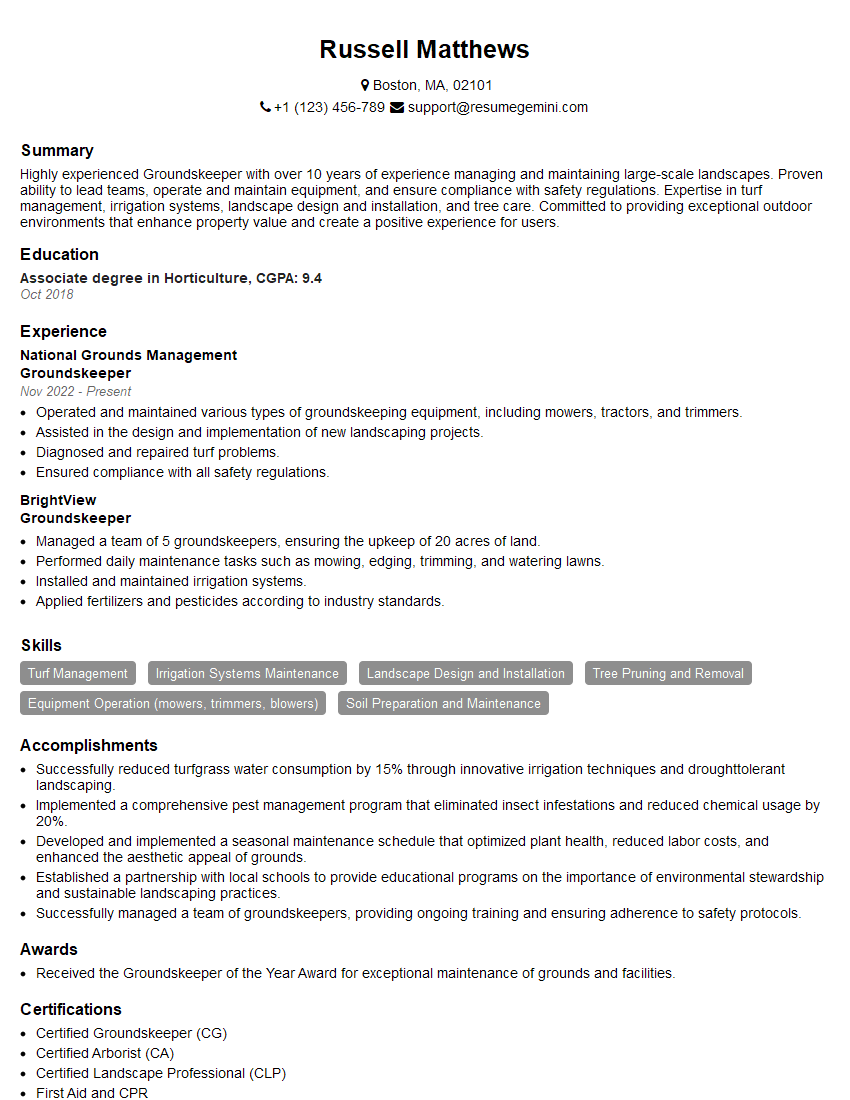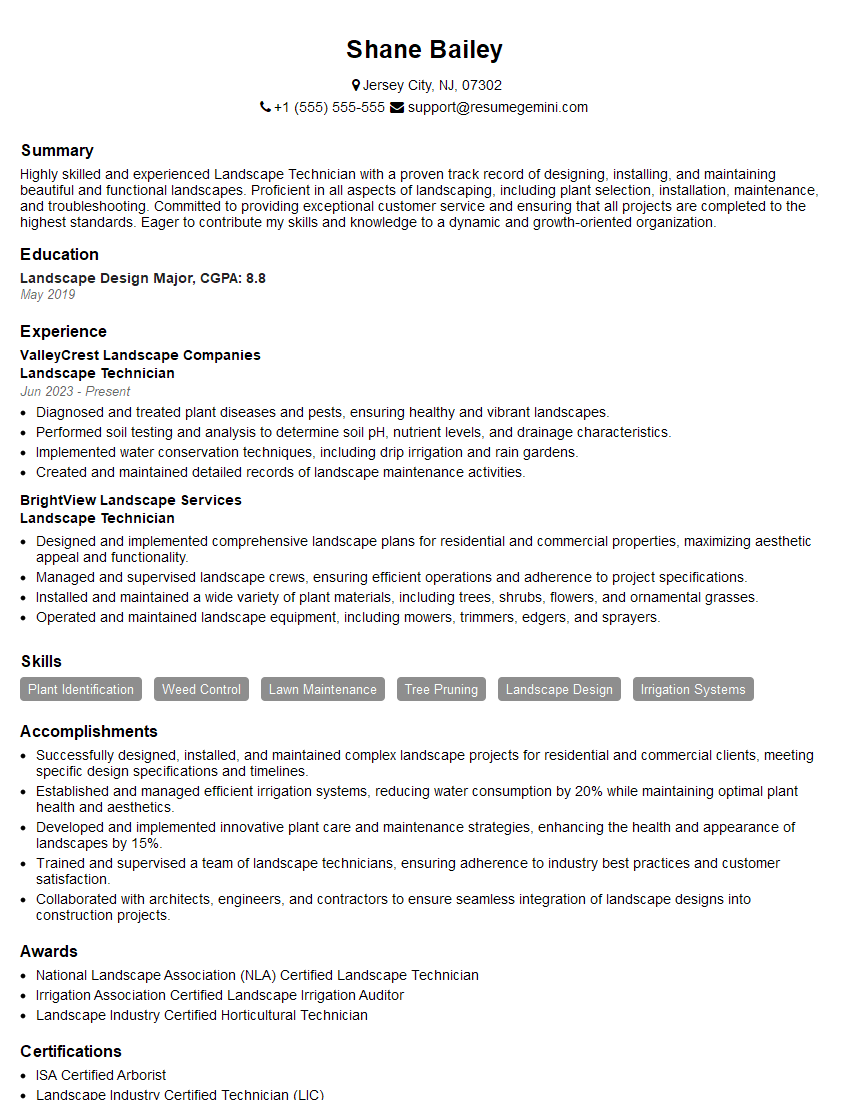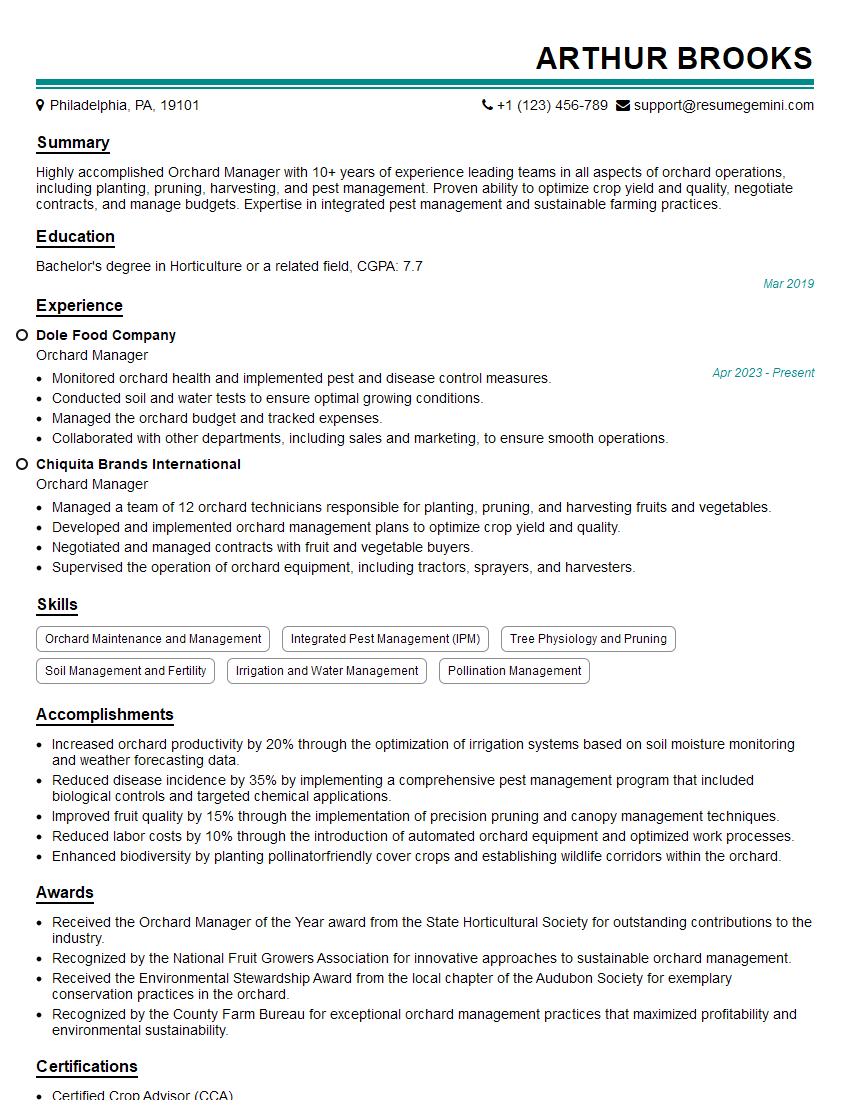Interviews are opportunities to demonstrate your expertise, and this guide is here to help you shine. Explore the essential Planting and Seeding interview questions that employers frequently ask, paired with strategies for crafting responses that set you apart from the competition.
Questions Asked in Planting and Seeding Interview
Q 1. Explain the different methods of seed sowing.
Seed sowing methods vary depending on the crop, scale of operation, and available resources. Broadly, they fall into these categories:
- Direct Sowing: Seeds are sown directly into the prepared soil where they will germinate and grow. This is common for crops like corn, wheat, and beans. Think of scattering seeds by hand in a garden – that’s direct sowing on a small scale. Larger operations use seed drills for precision planting.
- Indirect Sowing (or Transplanting): Seeds are initially sown in a nursery bed or seed tray, allowed to germinate, and then the seedlings are transplanted to their final growing location. This method is beneficial for delicate seedlings that might not survive direct sowing or for crops needing specific initial growing conditions, such as tomatoes or peppers. It offers better control over early growth and weed management.
- Broadcast Sowing: Seeds are scattered evenly over the soil surface. This method is simple but less precise, leading to uneven spacing and potentially higher competition among plants. It’s often used for cover crops or smaller gardens.
- Drilling: Seeds are sown in rows at a precise depth and spacing using a seed drill. This ensures uniform plant spacing, maximizing yield and facilitating efficient harvesting. This is the most common method for large-scale farming.
The choice of method depends on factors such as seed size, soil type, climate, and the desired level of control over plant spacing and growth.
Q 2. Describe the ideal soil conditions for planting various crops.
Ideal soil conditions vary significantly depending on the specific crop. However, some general principles apply:
- Well-drained soil: Most crops need soil that doesn’t become waterlogged, as this can lead to root rot. Good drainage allows for proper aeration, crucial for root growth.
- Appropriate pH: The soil pH (acidity or alkalinity) influences nutrient availability. For example, potatoes prefer slightly acidic soil (pH 5.5-6.5), while most legumes thrive in slightly alkaline soil (pH 6.0-7.5). Soil testing is essential to determine the existing pH and amend it if needed.
- Nutrient-rich soil: Crops need essential nutrients like nitrogen, phosphorus, and potassium. Healthy soil with sufficient organic matter usually provides these nutrients. However, additional fertilization might be required depending on soil test results.
- Proper soil structure: The soil should have a good balance of sand, silt, and clay to provide adequate drainage, aeration, and water retention. Clay soils can be improved by adding organic matter to enhance drainage. Sandy soils benefit from organic matter to increase water retention.
- Suitable soil temperature: Different crops have different temperature requirements for germination and growth. For example, warm-season crops like tomatoes need warmer soil temperatures than cool-season crops like lettuce.
For example, a farmer growing tomatoes would aim for well-drained, slightly acidic soil rich in organic matter and warm temperatures, while a farmer growing potatoes would prefer well-drained, slightly acidic soil with adequate drainage and cooler temperatures.
Q 3. What are the key considerations for seed depth and spacing?
Seed depth and spacing are critical for successful plant establishment. Getting it wrong can lead to poor germination, overcrowding, or stunted growth.
- Seed Depth: The ideal depth depends on seed size and soil type. Smaller seeds generally need to be planted shallower than larger seeds. Planting too deep can prevent seedlings from reaching the surface, while planting too shallow can leave seeds vulnerable to drying out or predation. A general rule of thumb is to plant seeds at a depth of about two to three times their diameter.
- Seed Spacing: The spacing between seeds and plants influences competition for resources like water, nutrients, and sunlight. Crowding leads to reduced yields and increased susceptibility to diseases and pests. Spacing depends on the mature size of the plant and its growth habit. A large plant like a sunflower needs more space than a smaller plant like a lettuce.
For instance, tiny lettuce seeds might be sown at a depth of about 1/4 inch and spaced 1 inch apart, while larger corn seeds may be planted at a depth of 1-2 inches and spaced 6-12 inches apart depending on the variety.
Q 4. How do you determine the appropriate planting density for a given crop?
Determining appropriate planting density involves considering several factors. The goal is to maximize yield while minimizing competition and stress on individual plants.
- Crop type: Different crops have different growth habits and space requirements.
- Variety: Even within a crop type, different varieties may have varying sizes and growth habits.
- Soil fertility: Richer soils can support higher planting densities.
- Climate: Optimal planting density might need adjustments based on rainfall, temperature, and sunlight.
- Available resources: Water and nutrient availability impact the number of plants a field can sustainably support.
Farmers often rely on research data, extension publications, and their own experience to determine optimal planting density. They might also conduct small-scale experiments to find the best density for their specific conditions. For example, a farmer might plant test plots with different densities of corn to assess yield and plant health under their specific conditions before committing to a large-scale planting.
Q 5. What are the common methods for irrigation and their suitability for different crops?
Irrigation methods vary greatly, each with advantages and disadvantages for different crops.
- Flood Irrigation: Water is applied to the entire field, allowing it to flow across the surface. It’s relatively inexpensive but can be wasteful and inefficient, leading to waterlogging and erosion. Suitable for crops that tolerate temporary flooding.
- Furrow Irrigation: Water is channeled into furrows or ditches between rows of plants. It’s less wasteful than flood irrigation but can still lead to uneven water distribution. Suitable for crops with deep root systems that can access water from the furrows.
- Drip Irrigation: Water is delivered directly to the plant roots through a network of tubes and emitters. It’s highly efficient, reducing water waste and improving water use efficiency. Suitable for many crops, especially high-value ones where water conservation is crucial.
- Sprinkler Irrigation: Water is sprayed onto the field using sprinklers. It’s versatile and can cover large areas but is more susceptible to water loss through evaporation and wind drift. Suitable for many crops but might not be ideal in windy conditions.
The choice of irrigation method depends on factors such as crop type, soil type, climate, water availability, and cost. For example, drip irrigation is excellent for tomatoes because it delivers water directly to the roots and minimizes leaf wetness, reducing disease risk. Flood irrigation might be suitable for rice, which thrives in flooded conditions.
Q 6. Explain the importance of soil testing before planting.
Soil testing before planting is crucial because it provides valuable information about the soil’s properties, enabling informed decisions about planting and crop management.
- Nutrient levels: It reveals the amounts of essential nutrients like nitrogen, phosphorus, potassium, and micronutrients present in the soil. This information guides fertilizer application, ensuring plants receive the required nutrients for optimal growth.
- Soil pH: It determines the soil’s acidity or alkalinity, which affects nutrient availability and the suitability of the soil for specific crops. Adjustments can be made to optimize the pH for specific crops.
- Soil texture: It assesses the proportions of sand, silt, and clay, indicating the soil’s drainage, water retention, and aeration capabilities. This helps in choosing appropriate crops and irrigation methods.
- Potential problems: Soil tests can reveal the presence of potential problems like salinity, compaction, or toxic substances, allowing for corrective measures before planting.
Imagine planting tomatoes in soil deficient in phosphorus. Without a soil test, you might not realize the deficiency, resulting in poor growth and reduced yield. A soil test would have alerted you to the problem, allowing you to apply phosphorus fertilizer and optimize the crop’s potential.
Q 7. Describe different types of fertilizers and their application methods.
Fertilizers provide essential nutrients to plants, boosting growth and yield. They come in various forms:
- Inorganic Fertilizers: These are synthetically produced and contain specific ratios of nitrogen (N), phosphorus (P), and potassium (K), often represented as NPK ratios (e.g., 10-10-10). They are readily available and provide a quick source of nutrients but can have environmental drawbacks if overused.
- Organic Fertilizers: These are derived from natural sources such as animal manure, compost, and seaweed. They release nutrients gradually, improving soil health in the long term. They are often preferred for environmentally sustainable agriculture but might not provide as immediate a nutrient boost as inorganic fertilizers.
- Slow-Release Fertilizers: These are designed to release nutrients over an extended period, reducing the frequency of application and minimizing nutrient runoff. They are particularly useful in situations where frequent fertilization is impractical or environmentally undesirable.
Application methods include:
- Broadcast: Spreading fertilizer evenly over the soil surface before planting.
- Banding: Applying fertilizer in bands near the seed or seedling.
- Side-dressing: Applying fertilizer alongside the row of established plants.
- Foliar application: Spraying fertilizer directly onto the leaves.
The best fertilizer type and application method depend on the crop, soil conditions, and environmental considerations. For example, a farmer might use a slow-release fertilizer for a long-season crop like corn to ensure consistent nutrient supply throughout the growing season.
Q 8. How do you control weeds and pests in a planted field?
Weed and pest control is crucial for successful crop production. It involves a combination of preventative and reactive measures, often employing an Integrated Pest Management (IPM) approach. This holistic strategy prioritizes minimizing pesticide use while maximizing effectiveness.
Preventative Measures: These aim to reduce pest and weed pressure before they become a significant problem. Examples include crop rotation (changing the type of crop planted each year to disrupt pest life cycles), using weed-free seed, practicing proper tillage to bury weed seeds, and selecting pest-resistant crop varieties.
Reactive Measures: These are employed when pests or weeds have already established themselves. This can involve:
Mechanical Control: Hand weeding, hoeing, mowing, and using tillage equipment to remove weeds.
Biological Control: Introducing natural enemies of pests, such as beneficial insects or nematodes, to control pest populations. For example, using ladybugs to control aphids.
Chemical Control: Using herbicides (for weeds) and insecticides (for pests) as a last resort. This requires careful selection of appropriate products and adherence to label instructions to minimize environmental impact and avoid harming beneficial organisms.
For example, in a corn field, we might use a combination of pre-emergent herbicides before planting to control weeds, followed by biological control methods like introducing parasitic wasps to control corn borers. Only if pest populations become unmanageable would targeted insecticides be considered.
Q 9. What are the signs of nutrient deficiencies in plants, and how do you address them?
Nutrient deficiencies manifest in various ways, depending on the nutrient lacking and the plant species. Recognizing these symptoms is crucial for timely intervention.
Visual Symptoms: These are often the first signs. For example, nitrogen deficiency causes pale green or yellow leaves, especially on older leaves. Phosphorus deficiency can lead to stunted growth and dark green or purplish leaves. Potassium deficiency results in yellowing or browning leaf margins. Iron deficiency leads to interveinal chlorosis (yellowing between leaf veins).
Soil Testing: A soil test provides a quantitative analysis of nutrient levels. This helps determine specific deficiencies accurately.
Plant Tissue Analysis: Analyzing plant tissue samples can provide information about the nutrient content of the plant itself, offering further confirmation of deficiencies.
Addressing Nutrient Deficiencies: The solution depends on the identified deficiency. It can involve:
Soil Amendments: Adding organic matter (compost, manure) improves soil structure and nutrient availability.
Fertilization: Applying fertilizers containing the deficient nutrients, either through broadcasting (spreading over the surface) or localized application (placing near plant roots).
Foliar Feeding: Spraying nutrient solutions directly onto the leaves for quick absorption.
For instance, if soil testing reveals a low potassium level, we would apply a potassium-rich fertilizer according to the soil test recommendations. The timing and method of application would depend on the crop and its stage of growth.
Q 10. How do you protect crops from frost or extreme weather conditions?
Protecting crops from frost or extreme weather depends on the type of weather event and the crop’s stage of growth. Strategies range from preventative measures to immediate responses.
Frost Protection: Methods include covering plants with frost cloths or blankets, using irrigation (water releases heat as it freezes, protecting plants from freezing temperatures), and planting in frost-protected locations. Certain crops might require cold frames or greenhouses for protection.
Extreme Heat Protection: Techniques include providing shade, using windbreaks to reduce wind damage, applying mulch to conserve soil moisture, and ensuring adequate irrigation. Some crops benefit from heat-tolerant varieties.
Wind and Hail Protection: Windbreaks and protective netting can minimize damage from strong winds and hail.
Drought Protection: Employing drought-tolerant crop varieties, implementing efficient irrigation systems (drip irrigation is especially effective), and applying mulch are all key.
As an example, for a citrus orchard threatened by frost, we might utilize overhead irrigation to protect the trees. During a heatwave, supplemental irrigation and shading may be necessary to prevent sunscald and wilting.
Q 11. Explain the process of seed germination.
Seed germination is a complex process where a seed transitions from a dormant state to an actively growing seedling. It requires specific environmental conditions.
Imbibition: The seed absorbs water, initiating metabolic activity. Water softens the seed coat and activates enzymes.
Enzyme Activation: Enzymes break down stored food reserves (starch, proteins) into simpler molecules usable by the embryo.
Cell Division and Elongation: The embryo begins to divide and grow, producing a radicle (primary root) and a plumule (shoot).
Radicle Emergence: The radicle emerges from the seed, anchoring the seedling and absorbing water and nutrients.
Plumule Emergence: The plumule emerges, developing into leaves that will carry out photosynthesis.
Factors affecting germination include: temperature, moisture, oxygen, and light (some seeds require light, others darkness). For example, corn seeds generally germinate best in warm, moist soil with sufficient oxygen. Lettuce seeds require light to germinate effectively.
Q 12. What are the different types of seeds and their characteristics?
Seeds are classified in several ways:
Size: Seeds vary greatly in size, from tiny grains (like poppy seeds) to large seeds (like pumpkins).
Shape: Seeds have diverse shapes – round, oval, flat, elongated, etc.
Dormancy: Some seeds have dormancy mechanisms, requiring specific conditions to germinate (e.g., stratification—exposure to cold temperatures).
Seed Coat: The seed coat’s thickness and hardness determine its permeability to water and oxygen, affecting germination.
Seed Type: This often refers to the plant’s reproductive structure. Examples include:
Monocots: Grasses, corn, rice, have a single cotyledon (embryonic leaf).
Dicots: Beans, sunflowers, tomatoes, have two cotyledons.
These characteristics influence planting methods and seed storage techniques. For example, small seeds are typically broadcast or drilled, while large seeds are usually planted individually.
Q 13. How do you ensure seed viability and longevity?
Maintaining seed viability and longevity requires proper storage conditions to minimize deterioration and prevent germination before planting.
Low Moisture Content: Seeds should be dried to a low moisture content (typically below 10%) before storage. High moisture content encourages fungal growth and seed decay.
Low Temperature: Cool, dry conditions are crucial for slowing down metabolic processes that can lead to deterioration. Refrigeration or freezing (for certain seeds) are common practices.
Airtight Containers: Storing seeds in airtight containers helps maintain low moisture content and protects against insect infestation.
Regular Testing: Periodic germination tests are essential to assess seed viability over time. This allows for adjusting storage conditions or replacing old seeds.
For example, storing vegetable seeds in a cool, dark place in airtight containers with low humidity is crucial for maintaining their viability for 1-2 years. Different seeds have varying storage requirements.
Q 14. Describe different methods of plant propagation.
Plant propagation, or increasing the number of plants, can be achieved through various methods:
Seed Propagation: Using seeds to grow new plants. This is the most common and natural method.
Vegetative Propagation: Producing new plants from vegetative parts, such as stems, leaves, or roots. This creates genetically identical clones. Examples include:
Cuttings: Taking stem or leaf sections and rooting them to produce new plants (e.g., propagating roses from stem cuttings).
Layering: Bending a stem to the ground, burying a portion, and encouraging root development (e.g., propagating raspberries).
Grafting: Joining a scion (desired plant part) onto a rootstock (existing plant) to create a new plant (e.g., grafting fruit trees).
Division: Separating a plant into multiple parts to create new plants (e.g., dividing perennials).
Tissue Culture: Growing plants from small pieces of plant tissue in a sterile nutrient medium (e.g., micropropagation).
The choice of method depends on several factors including the species, the desired quantity of plants, and resource availability. For example, roses are often propagated using cuttings, while fruit trees are frequently grafted to combine desirable traits from different varieties.
Q 15. Explain the importance of crop rotation.
Crop rotation is the practice of planting different types of crops in a planned sequence on the same piece of land over several growing seasons. It’s like giving your soil a balanced diet! Instead of repeatedly growing the same crop, which depletes specific nutrients, you rotate to replenish them and improve soil health.
- Reduced pest and disease pressure: Rotating crops disrupts the life cycle of many pests and diseases that thrive on specific plants. For instance, planting a legume after a cereal crop can reduce nematode populations.
- Improved soil fertility: Different plants have different nutrient requirements. Legumes, for example, fix nitrogen in the soil, enriching it for subsequent crops. This reduces the need for synthetic fertilizers.
- Weed control: Rotating crops with varying growth habits can help suppress weeds. A dense cover crop, for instance, can effectively smother unwanted vegetation.
- Enhanced soil structure: Different root systems of various crops improve soil structure, aeration, and water infiltration, preventing compaction.
Example: A common rotation might be corn (heavy feeder), soybeans (nitrogen fixer), and wheat (moderate feeder). This sequence helps maintain soil fertility and reduces pest pressure.
Career Expert Tips:
- Ace those interviews! Prepare effectively by reviewing the Top 50 Most Common Interview Questions on ResumeGemini.
- Navigate your job search with confidence! Explore a wide range of Career Tips on ResumeGemini. Learn about common challenges and recommendations to overcome them.
- Craft the perfect resume! Master the Art of Resume Writing with ResumeGemini’s guide. Showcase your unique qualifications and achievements effectively.
- Don’t miss out on holiday savings! Build your dream resume with ResumeGemini’s ATS optimized templates.
Q 16. How do you manage soil erosion and improve soil health?
Managing soil erosion and improving soil health are crucial for long-term agricultural sustainability. Think of it as protecting the foundation of your farm.
- Conservation tillage: Minimizing soil disturbance through no-till or reduced-till farming practices protects soil structure and reduces erosion. This involves leaving crop residue on the soil surface to act as a mulch.
- Cover cropping: Planting cover crops during fallow periods protects the soil from erosion, improves soil structure, and adds organic matter. These are like a soil’s protective blanket.
- Contour farming: Planting along the contours of the land slows water runoff, reducing erosion. Imagine drawing lines across a hillside rather than straight up and down.
- Terracing: Creating level platforms on slopes reduces the slope’s angle, minimizing water flow and erosion. This creates steps on steep land.
- Windbreaks: Planting trees or shrubs to reduce wind speeds can significantly reduce wind erosion, particularly in arid or semi-arid regions.
- Crop rotation (as mentioned above): Improves soil health, leading to better erosion resistance.
- Adding organic matter: Incorporating compost, manure, or other organic materials increases soil organic matter, improving water retention and reducing erosion.
Example: A farmer in a hilly region might use contour farming and terracing to reduce erosion while using cover crops to improve soil health during the off-season.
Q 17. What are the benefits and drawbacks of using genetically modified seeds?
Genetically modified (GM) seeds are seeds that have been genetically altered to enhance certain traits. It’s like giving plants superpowers!
Benefits:
- Increased yields: GM crops can produce higher yields, contributing to food security.
- Pest resistance: GM crops engineered to resist specific pests can reduce pesticide use, benefiting the environment and reducing costs.
- Herbicide tolerance: GM crops tolerant to certain herbicides allow for more effective weed control.
- Improved nutritional value: GM crops can be modified to have enhanced nutritional content.
Drawbacks:
- Potential environmental risks: Concerns exist regarding the potential impact of GM crops on biodiversity, particularly the development of herbicide-resistant weeds.
- Health concerns: Although extensive research indicates GM crops are safe for human consumption, some concerns remain.
- Economic implications: The high cost of GM seeds can disproportionately affect small-scale farmers.
- Ethical considerations: Ethical concerns exist regarding the control of the seed supply by large corporations.
Example: Bt corn is a GM crop engineered to resist the European corn borer, reducing the need for insecticides.
Q 18. What is the role of cover crops in sustainable agriculture?
Cover crops are plants grown primarily for their benefits to the soil rather than for direct harvest. Think of them as soil superheroes.
- Soil erosion control: Their extensive root systems and dense foliage protect the soil from wind and water erosion.
- Improved soil structure: Cover crops improve soil structure through their root systems, enhancing aeration and water infiltration.
- Nutrient cycling: Cover crops effectively cycle nutrients in the soil, making them available for subsequent crops. Legumes, for example, fix atmospheric nitrogen.
- Weed suppression: Cover crops can suppress weeds, reducing competition for resources.
- Pest and disease control: Some cover crops can suppress soilborne pests and diseases.
- Increased organic matter: When incorporated into the soil, cover crops add organic matter, enhancing soil fertility and water-holding capacity.
Example: Rye, clover, and vetch are commonly used cover crops.
Q 19. Explain the concept of precision agriculture and its applications in planting and seeding.
Precision agriculture uses technology to optimize agricultural practices. It’s like having a GPS for your farm, optimizing efficiency and resource use.
Applications in planting and seeding:
- Variable-rate technology: Allows for precise application of seeds, fertilizers, and pesticides based on site-specific conditions, maximizing efficiency and minimizing waste.
- GPS-guided planting: Ensures accurate seed placement and spacing, optimizing crop growth and yield.
- Remote sensing: Uses satellites or drones to monitor crop health and identify areas needing attention, enabling timely interventions.
- Data analysis: Integrates data from various sources to create maps of soil conditions, yield variations, and other factors, informing better decision-making.
Example: A farmer using GPS-guided planting can ensure uniform seed spacing and depth, resulting in a more uniform crop stand and improved yield.
Q 20. How do you monitor plant growth and health?
Monitoring plant growth and health is essential for timely intervention and maximizing yields. It’s like being a plant doctor.
- Visual observation: Regular field walks to assess plant growth, color, and overall health are crucial.
- Remote sensing: Utilizing drones or satellite imagery can provide a broader view of the crop’s condition, identifying stress areas.
- Soil testing: Regular soil tests reveal nutrient levels, pH, and other factors affecting plant growth.
- Plant tissue analysis: Analyzing plant tissues provides insights into nutrient deficiencies or toxicities.
- Yield monitoring: Harvesting equipment equipped with sensors can measure yield variations across the field, guiding management decisions in subsequent seasons.
Example: Yellowing leaves might indicate a nutrient deficiency, prompting a soil test and appropriate fertilization.
Q 21. Describe the importance of record-keeping in planting and seeding operations.
Record-keeping in planting and seeding is vital for improving efficiency and making informed decisions. It’s like maintaining a detailed diary for your farm.
- Tracking planting dates: Accurate records of planting dates are crucial for crop scheduling and yield prediction.
- Seed variety and quantity: Recording seed variety, quantity, and source enables better selection and cost management in the future.
- Fertilizer and pesticide applications: Maintaining records of applied fertilizers and pesticides ensures appropriate management of these inputs and avoids overuse.
- Yield data: Tracking yields over time provides crucial data for evaluating management strategies and improving efficiency.
- Weather data: Recording rainfall, temperature, and other weather data helps understand environmental factors influencing crop growth and yield.
Example: Detailed records allow for tracking the effectiveness of different seed varieties or fertilizer types, guiding future decisions.
Q 22. What are some common planting and seeding equipment and their operation?
Planting and seeding equipment varies greatly depending on the scale of operation and the crop being planted. For small-scale gardening, simple hand tools like shovels, trowels, and hand seeders suffice. However, large-scale agricultural operations rely on sophisticated machinery.
- Tractor-mounted planters: These precision machines plant seeds at precise depths and spacings, significantly increasing efficiency. They often incorporate features like fertilizer application and seed metering mechanisms. Operation involves calibrating the planter to the specific seed type and desired planting density, then attaching it to a tractor and driving across the field.
- Seed drills: These machines are ideal for planting seeds in rows, offering excellent control over seed placement. They can be pulled by tractors or, in smaller versions, even by hand. Operation involves setting the desired row spacing and seed depth, and ensuring even seed flow.
- Air seeders: These are best suited for large-scale operations, particularly in areas with challenging terrain. They distribute seeds via an airflow system, making them suitable for various seed types and soil conditions. Operation requires precise calibration of the airflow and seeding rate for optimal seed distribution.
- Transplanters: Used for transplanting seedlings (like tomatoes or rice), these machines carefully place seedlings into the soil at the correct spacing. Operation involves loading the seedlings into the transplanter’s hopper and adjusting the machine for appropriate planting depth and spacing.
Choosing the right equipment hinges on factors such as field size, crop type, soil conditions, and budget. For instance, a small vegetable farm might utilize a seed drill, whereas a large-scale grain farm would opt for a tractor-mounted planter or air seeder.
Q 23. How do you handle planting and seeding in different soil types?
Soil type significantly influences planting and seeding strategies. Different soils have varying drainage, nutrient content, and workability. Consider these adaptations:
- Sandy soils: These soils drain quickly, often requiring more frequent watering and potentially the addition of organic matter to improve water retention. Planting depth might need adjustment to prevent seeds from drying out. We may use a soil conditioner to improve seed-to-soil contact.
- Clay soils: These soils can be heavy and compact, leading to poor drainage and aeration. Planting might require tillage to improve soil structure before planting. We often select seeds that tolerate compaction or use techniques like no-till planting.
- Loamy soils: These are ideal planting mediums, offering good drainage, aeration, and water retention. Planting techniques are generally straightforward, focusing on proper seed depth and spacing.
Soil testing is crucial for determining nutrient levels and pH, enabling us to amend the soil as needed with fertilizers or soil conditioners to create an optimal growing environment. For example, adding lime to acidic clay soils can improve their structure and nutrient availability.
Q 24. Describe your experience with various planting and seeding techniques.
My experience encompasses a wide range of planting and seeding techniques, from conventional tillage methods to more sustainable approaches. I’ve worked extensively with:
- Conventional Tillage: This involves plowing and harrowing to prepare the seedbed. While effective, it can lead to soil erosion and compaction. It is most suitable for heavy clay soils needing improved structure.
- No-Till Farming: This method avoids tillage, minimizing soil disturbance. Seeds are planted directly into the residue of the previous crop, reducing erosion and improving soil health. It is ideal for sandy soils or those prone to erosion. We often use a no-till drill for this.
- Direct Seeding: This involves planting seeds directly into the soil without prior preparation, which is efficient and cost-effective. Requires careful consideration of soil conditions and seed viability.
- Broadcast Seeding: Seeds are scattered over the soil surface, which is suitable for small seeds or cover crops but may result in uneven plant spacing. This can be done by hand or with mechanical spreaders.
- Precision Seeding: This highly accurate method places seeds at precise intervals, maximizing yield and resource efficiency. It’s typically done with modern planting machinery.
The choice of technique depends on the crop, soil type, climate, and overall farming goals. For instance, no-till farming is often favored in environmentally sensitive areas.
Q 25. How do you adapt planting strategies to changing environmental conditions?
Adapting to changing environmental conditions is critical for successful planting and seeding. Factors like temperature, rainfall, and sunlight significantly influence seed germination and plant growth.
- Temperature: Planting time needs to be carefully chosen to coincide with optimal temperatures for germination and growth. Cold temperatures can delay germination, whereas extreme heat can damage seeds. We might adjust planting depth or use seed treatments to protect against temperature extremes.
- Rainfall: Sufficient moisture is essential for seed germination. Drought conditions might necessitate irrigation or planting during periods of higher rainfall. We can use drought-resistant seed varieties or adjust planting density to reduce competition for water.
- Sunlight: The amount of sunlight a crop needs influences planting location and spacing. Shade-tolerant crops can be planted in areas with less sunlight. We may also adjust row spacing to ensure adequate sunlight reach for each plant.
Weather forecasting and historical climate data are valuable tools for making informed decisions about planting schedules and strategies. For example, a prediction of drought may lead us to select drought-tolerant crop varieties and implement supplemental irrigation plans.
Q 26. What safety measures do you take during planting and seeding operations?
Safety is paramount during planting and seeding operations. Common hazards include:
- Machinery-related accidents: Operating heavy machinery like tractors and planters requires careful attention to safety protocols. This includes regular equipment maintenance, wearing appropriate safety gear (e.g., safety glasses, hearing protection, and sturdy footwear), and adhering to strict operational guidelines. We use lockout/tagout procedures when servicing equipment.
- Chemical exposure: Working with pesticides and herbicides necessitates the use of protective clothing, gloves, and respirators. Strict adherence to label instructions is essential to avoid health risks. Proper disposal of empty containers is crucial.
- Ergonomic injuries: Repetitive movements during hand planting or seeding can lead to muscle strain. We use ergonomic tools, take frequent breaks, and encourage proper lifting techniques to minimize risks.
- Weather-related hazards: Extreme weather conditions (e.g., heat, cold, storms) pose risks to workers. We monitor weather forecasts and suspend operations when necessary to protect our team.
Regular safety training and risk assessments are vital in mitigating these hazards and ensuring a safe working environment.
Q 27. Explain your experience with troubleshooting planting and seeding problems.
Troubleshooting planting and seeding problems requires systematic investigation. I typically follow these steps:
- Identify the problem: Precisely describe the issue – uneven emergence, poor germination, low plant density, etc.
- Inspect the seeds: Check for seed viability and quality. Damaged or old seeds may fail to germinate.
- Assess soil conditions: Test soil moisture, pH, and nutrient levels. Issues like compacted soil or nutrient deficiencies can hinder germination and growth.
- Examine planting equipment: Check for malfunctions in planters or seed drills. Incorrect seed depth, spacing, or seed metering could be the cause.
- Evaluate environmental factors: Consider the impact of temperature, rainfall, and sunlight on plant growth. Unusual weather patterns can affect germination and seedling establishment.
- Implement corrective measures: Based on the identified causes, apply appropriate solutions – replanting, soil amendment, equipment repair, irrigation, or pest control.
- Monitor and adjust: Continuously monitor the crop’s progress and make necessary adjustments to optimize growth.
For instance, if I observe poor germination, I might check seed viability, examine soil moisture levels, and ensure the planter was properly calibrated. If the problem persists, I would consider soil testing to identify any nutrient deficiencies.
Q 28. How do you stay updated on the latest advancements in planting and seeding technologies?
Staying updated on advancements in planting and seeding technologies is crucial for maintaining a competitive edge. I utilize several methods:
- Industry publications and journals: Regularly reading agricultural publications keeps me informed about the latest research and technological developments.
- Conferences and workshops: Attending industry conferences and workshops allows for networking and learning from experts in the field.
- Online resources and webinars: Many online resources, including university extension programs and industry websites, offer valuable information and training opportunities.
- Manufacturer websites and brochures: Staying updated on the newest planting and seeding equipment from leading manufacturers is essential for adopting efficient techniques.
- Networking with peers and professionals: Exchanging information and experiences with other professionals in the field is a vital source of knowledge.
For example, I recently attended a conference that focused on precision agriculture and learned about new sensor technologies that optimize seed placement and fertilizer application. This allows for higher efficiency and reduced waste, improving both yield and sustainability.
Key Topics to Learn for Planting and Seeding Interview
- Soil Preparation: Understanding soil types, testing methods, and appropriate tillage techniques for optimal seed germination and plant growth. Practical application: Explaining your experience with different soil amendment strategies and their impact on yield.
- Seed Selection and Handling: Choosing the right seed variety based on climate, soil conditions, and desired outcome. Practical application: Describing your experience with seed viability testing and storage methods to ensure high germination rates.
- Planting Methods: Mastering various planting techniques (direct seeding, transplanting, precision planting) and their suitability for different crops and scales of operation. Practical application: Discussing your experience with different planting equipment and their maintenance.
- Seed Spacing and Depth: Understanding the importance of proper spacing and planting depth for maximizing yield and minimizing competition. Practical application: Explaining how you’ve adjusted planting techniques based on specific crop requirements and environmental factors.
- Crop Establishment: Optimizing post-planting practices (irrigation, fertilization, pest and weed control) to ensure healthy crop establishment. Practical application: Describing your experience with irrigation scheduling and weed management strategies.
- Precision Agriculture Technologies: Familiarity with GPS-guided planting, variable rate technology, and data analysis for optimizing planting efficiency and yield. Practical application: Discussing your experience with data-driven decision-making in planting and seeding operations.
- Troubleshooting and Problem Solving: Identifying and addressing common challenges in planting and seeding, such as poor germination, uneven emergence, and pest infestations. Practical application: Describing a time you encountered a problem during planting and how you solved it.
Next Steps
Mastering planting and seeding techniques is crucial for a successful career in agriculture, opening doors to diverse roles and opportunities for advancement. A strong understanding of these principles demonstrates practical skills and problem-solving abilities highly valued by employers. To maximize your job prospects, it’s essential to create an ATS-friendly resume that highlights your skills and experience effectively. ResumeGemini is a trusted resource to help you build a professional and impactful resume. Examples of resumes tailored to Planting and Seeding roles are available to guide you through the process.
Explore more articles
Users Rating of Our Blogs
Share Your Experience
We value your feedback! Please rate our content and share your thoughts (optional).
What Readers Say About Our Blog
Hello,
We found issues with your domain’s email setup that may be sending your messages to spam or blocking them completely. InboxShield Mini shows you how to fix it in minutes — no tech skills required.
Scan your domain now for details: https://inboxshield-mini.com/
— Adam @ InboxShield Mini
Reply STOP to unsubscribe
Hi, are you owner of interviewgemini.com? What if I told you I could help you find extra time in your schedule, reconnect with leads you didn’t even realize you missed, and bring in more “I want to work with you” conversations, without increasing your ad spend or hiring a full-time employee?
All with a flexible, budget-friendly service that could easily pay for itself. Sounds good?
Would it be nice to jump on a quick 10-minute call so I can show you exactly how we make this work?
Best,
Hapei
Marketing Director
Hey, I know you’re the owner of interviewgemini.com. I’ll be quick.
Fundraising for your business is tough and time-consuming. We make it easier by guaranteeing two private investor meetings each month, for six months. No demos, no pitch events – just direct introductions to active investors matched to your startup.
If youR17;re raising, this could help you build real momentum. Want me to send more info?
Hi, I represent an SEO company that specialises in getting you AI citations and higher rankings on Google. I’d like to offer you a 100% free SEO audit for your website. Would you be interested?
Hi, I represent an SEO company that specialises in getting you AI citations and higher rankings on Google. I’d like to offer you a 100% free SEO audit for your website. Would you be interested?
good

